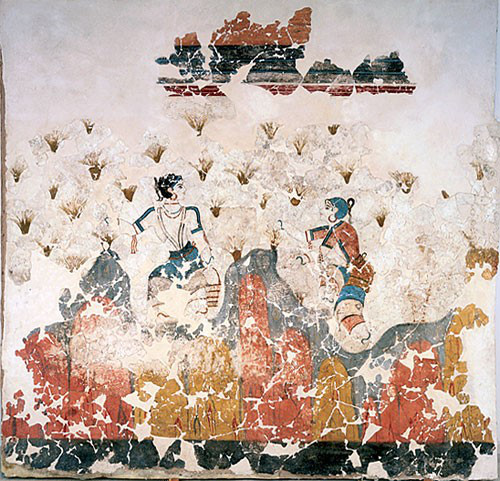By Charlie Campbell

In Scandinavia, particularly Sweden and Norway, Saffron is associated with advent, Christmas, yule and especially Saint Lucia’s night. The convoluted history of solstice celebrations may be read elsewhere but the fragrant, orangey stigmas of Crocus sativus suffuse celebrations of the ending of the year in the form of Lussebullar.

Saffron has famously been, pound for pound, worth more than its weight in gold (Kafi et al. 2006); and has been known, and grown for 1000s of years. The origins of widely, and long cultivated crops can be quite difficult to pin down. This is especially true in Saffron as the parts essential for identification do not preserve well. Minoan art from Crete depicting ‘the Saffron gatherers’ is indicative that it has been used since at least 1645 BCE.
It is thought that Saffron as it is known stems from one of three parent species; C. cartwrightianus, C. thomasii and C. pallasii from somewhere in Greece (Caiola et al. 2004; Alsayied 2015). Its reproduction is entirely vegetative, being not only self-incompatible, but also male sterile. Its continuation, therefore, has been solely dependent on man’s horticultural pursuits. There is so little genetic variation in the species that each individual plant is practically genetically identical to the rest of the plants in the field (Rubio-Moraga et al. 2009).
Its long history with agriculture has meant that there are several stories interwoven with its history. Alexander the Great used Saffron infused baths to heal not only his but also the wounds of his common soldiers. It may have arrived into Britain in the 1350s by being smuggled within a hollowed out pilgrim’s staff (Willard 2002).

Despite mankind’s link with Saffron, its cultivation waxes and wanes throughout its history. The economics of its production requires access to abundant cheap labour, needed particularly during the short 3 week harvesting season(Kafi et al. 2006). Recently it has been re-introduced as a commercial crop into the UK after a 200 year absence close to the eponymously named Saffron Waldon.(Telegraph 2014)
There is some evidence to support the idea that Saffron can aid in the treatment of mild to moderate depression(Lopresti & Drummond 2014), so perhaps its association with the darker times of the year is not surprising.
References
Alsayied, N., 2015. Molecular diversity and relationships of saffron and wild crocus species.
Anon, 2014. Putting saffron back into Saffron Walden. Telegraph. Available at: http://www.telegraph.co.uk/news/earth/agriculture/farming/11212315/Putting-saffron-back-into-Saffron-Walden.html [Accessed December 6, 2015].
Caiola, M., Caputo, P. & Zanier, R., 2004. RAPD analysis in Crocus sativus L. accessions and related Crocus species. Biologia Plantarum.
Kafi, M. et al., 2006. Saffron (Crocus sativus) Production and Processing, Science Publishers.
Lopresti, A.L. & Drummond, P.D., 2014. Saffron (Crocus sativus) for depression: a systematic review of clinical studies and examination of underlying antidepressant mechanisms of action. Human psychopharmacology, 29(6), pp.517–27.
Rubio-Moraga, A. et al., 2009. Saffron is a monomorphic species as revealed by RAPD, ISSR and microsatellite analyses. BMC research notes, 2, p.189.
Willard, P., 2002. Secrets of Saffron: The Vagabond Life of the World’s Most Seductive Spice, Beacon Press.
